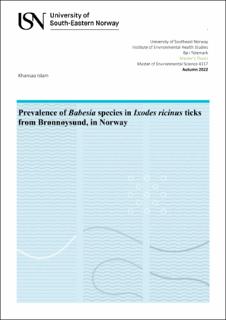| dc.description.abstract | Babesiosis in cattle caused by blood borne parasites in the genera Babesia. The disease has shown an increasing trend in Europe over the last decades and are already considered a major threat to livestock in several countries. The only two species of Babesia to infect cattle in northern Europe are Babesia divergens and Babesia major where B. divergens being the more common. Knowledge of how these protozoic pathogens is distributed through Europe and how they are transmitted to cattle are of major importance. It is also important to gain knowledge about the tick vector Ixodes ricinus and its complex transmission cycle in relation to Babesia spp. Climatic changes, and subsequently changes in the distribution and density of different reservoir hosts and the tick vector, might be reasons causing the increase of babesiosis in Europe.
The first aim of this master thesis was to investigate the prevalence of Babesia spp. in I. ricinus nymph ticks from a farmland of Brønnøysund (Nordland County) which was reported to have cases of babesiosis in cattle. All the ticks were collected by dragging a flannel cloth in a typical tick habitat adjacent to the farm in September 2019. Ten adult ticks were sampled and used for methodological development. 250 nymphs were screened for Babesia spp. with an “in house” real-time polymerase chain reaction (PCR). Some Babesia positive tick samples were confirmed by pyrosequencing. Due to lack of time, only a subset of seven randomly chosen nymph samples were pyrosequenced. Our results indicated that 51.6% of the ticks were positive in Brønnøysund, which was surprising since such high prevalence of Babesia was previously not reported in Norway.
To get more knowledge about infection rate of Babesia spp. in Norway, 96 nymph ticks from Hille (Agder County) and 96 nymph ticks from Haugesund (Rogaland County) was collected and analyzed as described above. Hille is an island in the southernmost part of Norway, and the tick sampling location is close to a grazing area for cattle. In the location in Haugesund no cattle were present. Seven random samples from Hille were pyrosequenced. Due to lack of time no samples from Haugesund were confirmed by pyrosequencing. Almost 47% of the ticks at Hille was positive for Babesia spp. The most likely explanation for these findings could be due to our modification in methodology. However, a combination of direct and indirect effects on the pathogen by climate, reservoir host and tick population density and other effects such as migration of birds, rise in cattle movement inland or across neighboring countries can also be reasons for the prevalence of Babesia spp. A study with more samples from different sites collected at different seasons need to be conducted to make precise conclusions. | |
